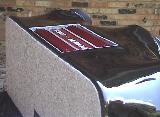Car Audio Fiberglass Fabrication Basics
In this article I'm going to cover some of the basics you will need to know about fiberglass to successfully create your own projects.
What is Fiberglass?
Fiberglass is a woven mat or cloth made from tiny glass fibers. When saturated with polyester resin it hardens into a very strong structure. This is what is used to create many custom car audio projects. It's also how Corvette bodies and boat hulls are fabricated.
But when we say "fiberglass" in the car audio realm it doesn't always mean true fiberglass. Many times we will use a different type of cloth with the polyester resin. This is because we want to form specific shapes that would fall apart if we tried to do it with fiberglass mat. These cloths are usually polyester based and are stretchable to conform to the curves we need to create.
We also use automotive body filler to further shape and strengthen our projects. This includes both regular filler such as Bondo and fiberglass reinforced fillers such as Kitty Hair. They each serve a specific purpose when creating custom installations.
Fiberglass Step by Step
There are three basic steps to creating nearly any fiberglass project. It doesn't matter if it's a kickpanel pod or a subwoofer enclosure. They all follow the same route.
The first step is to create a base to work from. For a kickpanel this might be the factory kickpanel or a mold taken from the kickpanel area. For an enclosure this might be a wooden box or a fiberglass mold of the spare tire well. We need this base so that we can create our next step.
Step two is the creation of a frame. This is what we will mount to the base and use to create the form for our project. The frame is almost always created from MDF. For speakers it means creating a set of mounting rings and a set of supports to prop the rings on the base. Once this skeleton is in place we're ready to put the skin on it.
The final step in the creation is the wrapping and shaping. We take our polyester based cloth and wrap it around our frame, holding it in place with spray glue or staples. This gives us a good idea of what our final project will look like. After all of the wrinkles have been pulled out of the cloth we coat the cloth with fiberglass resin. This will cure and harden our cloth onto the frame. Once we have a stiff surface we can strengthen it with fiberglass and/or body filler. The body filler will help fill in any gaps and give us a surface that can be sanded for carpet, vinyl or paint.
Is it Difficult to Do?
Working in fiberglass is not that difficult if you follow the steps. Like any new skill it takes time to master. It's not like replacing a head unit where you're just removing panels and screws. Fiberglass lets you take your own ideas and creativity to make completely custom projects. It's as close as we come to creating art in the automotive environment.
Who Should Try It?
If you are impatient or don't like working with your hands then fiberglass is not for you. It takes a level of discipline and desire to create worthwhile projects. But if you like to create and want something more interesting than a basic installation then it's definitely something you'll want to try. It's the first step towards becoming a great installer capable of world class installations.

You should check out Fiberglass Fabrication I. It covers an introduction to fiberglass work with sections on kick panel speakers pods, MDF enclosures with curved fiberglass baffles and spare tire subwoofer enclosures. Click here.

For those with fiberglass experience or who want to create more advanced fiberglass projects Fiberglass Fabrication II has just been released. It shows you how to create vehicle molded subwoofer enclosures, multiple woofer/amp rack combinations and custom door panels. Click here.
Both DVDs are available together at a special price.
Back to the Newsletter Archives Index